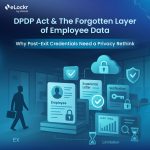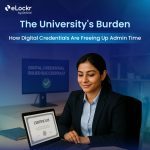Universities across India are facing a growing administrative challenge: issuing, verifying, and managing academic credentials for thousands of students every year. As demands for academic verification rise from employers, foreign universities, government bodies, and the students themselves, institutions are stretched thin trying to process requests, confirm records, and prevent forgery.
This traditional, paper-heavy process is not only time-consuming but also inefficient and vulnerable to fraud.
Enter Digital University Credentials—a modern, tech-driven solution that is transforming how academic institutions manage credentials while drastically reducing administrative overhead. In this blog, we explore the burden faced by university administrations today, how digital credentials are changing the game, and how eLockr is helping institutions unlock new efficiencies while empowering students.
The Credentialing Crisis in Indian Universities
India has over 1,000 universities and 40,000+ colleges, producing millions of graduates each year. For every student, universities must manage:
- Degree certificates
- Transcripts and mark sheets
- Provisional certificates
- Letters of recommendation
- Verification letters for employers or foreign admissions
Each of these credentials is critical for the student’s academic and professional journey—and universities are inundated with verification requests from employers, background check agencies, embassies, and more
The result?
- Delayed verification turnaround times
- Burdened admin departments struggling to track, print, seal, and dispatch documents
- High error rates due to manual processes
- Reputational risk from credential fraud and misrepresentation
This creates friction not only for the university but also for the students and third parties relying on those credentials for timely decisions.
Digital University Credentials: A Smarter Way Forward
Digital University Credentials refer to academic documents that are issued, stored, and shared electronically—secured with encryption, authenticated via blockchain or unique identifiers, and instantly shareable by students themselves. Instead of responding manually to each verification request, universities can issue credentials once and let students share verified copies digitally, as and when needed.
Benefits of Digital Credentials for Universities:

✅ Frees Up Admin Resources
Once digital credentials are issued, admin teams don’t need to repeatedly process document requests or verify records manually.
✅ Faster Verification Turnaround
Employers and institutions can verify credentials instantly—without emailing registrars or waiting for weeks.
✅ Prevents Document Forgery
Digital credentials are secure, tamper-proof, and traceable—unlike scanned or photocopied certificates.
✅ Improves Student Experience
Students can access their credentials anytime and share them with a few clicks, enhancing their academic and career opportunities.
✅ Supports Remote Operations
Especially post-pandemic, universities need cloud-ready tools that work without physical visits or paperwork
How eLockr Supports Digital University Credentials
At eLockr, we believe that academic credentials should be secure, shareable, and self-sovereign. That’s why we’ve built a platform that empowers universities to issue Digital University Credentials with ease—and gives students full control over how and when to share them.
Here’s how eLockr is transforming the credentialing process for institutions and learners alike:
1. Credential Digitization & Secure Storage
Universities can digitize certificates, mark sheets, and transcripts using eLockr’s secure cloud platform. Each credential is encrypted, tagged with a unique ID, and stored in a verified record vault.
- No paperwork
- No printing
- No risk of loss or duplication
2. Self-Managed Sharing by Students
Once credentials are uploaded to eLockr, students receive access to their own verified profile. From here, they can share credentials with employers, background verification agencies, or international institutions—right from their phone or laptop.
- One-click sharing via email or link
- Real-time activity logs
- Controlled access (with expiration and view limits)
This drastically reduces the number of requests universities receive for verification—because students can now handle it themselves, with confidence.
3. Tamper-Proof & Verifiable
Every credential issued through eLockr carries an embedded verification mechanism. This could be a digital signature, a blockchain hash, or a secure QR code.
Anyone receiving the credential can verify its authenticity instantly on eLockr—no need to call or email the registrar.
This adds credibility to the student’s profile and protects the institution’s reputation.
4. Audit Trail and Compliance
For every credential issued and shared, eLockr maintains a tamper-proof audit trail. Universities can track document access, sharing history, and even receive alerts in case of suspicious activity.This ensures compliance with privacy norms and education board regulations, including NEP 2020’s digital education mandate.
Real Impact: Saving Time, Reducing Costs
By switching to eLockr universities can:
- Reduce document processing time by over 70%
- Cut down admin workload on credential requests by 60–80%
- Avoid courier and printing costs
- Improve student satisfaction and brand perception
Most importantly, institutions reclaim valuable time—time they can redirect toward academics, research, innovation, and student support.
Why It Matters Now
As India’s education sector embraces digitization under the Digital India and NEP 2020 initiatives, modern credentialing is no longer a luxury—it’s a necessity.
Global universities, employers, and visa authorities now expect instant, secure verification. Students, too, demand faster access to their records for job applications, study abroad, and online learning platforms.
Universities that fail to modernize risk falling behind in both student satisfaction and global competitiveness.
The Road Ahead: Empowering Universities, Empowering Students
Digital University Credentials aren’t just about reducing paperwork—they’re about building trust, improving efficiency, and future-proofing education.
With eLockr, Indian universities can:
- Digitize and protect academic records
- Eliminate manual verification backlogs
- Empower students to manage and share their credentials
- Strengthen institutional credibility and innovation
Whether you’re a registrar, dean, or IT administrator, the message is clear: it’s time to let go of outdated processes and embrace a smarter, digital-first approach.
Start Your Digital Credentialing Journey Today
Ready to reduce admin time and streamline your credential process? eLockr is here to help.
Explore how our Digital University Credentials solution can work for your institution. Visit https://elockr.io or request a demo today.
FAQs
1. What are Digital University Credentials, and how are they different from traditional certificates?
Digital University Credentials are academic documents like degrees, transcripts, and certificates that are issued, stored, and shared electronically. Unlike traditional paper certificates, they are secure, tamper-proof, and instantly verifiable through digital means.
2. How do Digital Credentials help reduce the administrative burden for universities?
Digital credentials eliminate the need for repeated manual verifications and document processing. Once issued, they can be shared directly by students, reducing the volume of verification requests universities must handle.
3. Can students share their digital credentials with employers or international institutions?
Yes. Platforms like eLockr allow students to manage and share their verified credentials with one click, making it easy to apply for jobs, higher education, or visas without delays or paperwork.
4. Are digital credentials secure and fraud-proof?
Absolutely. Digital credentials issued via eLockr include built-in verification tools like QR codes, blockchain hashes, or digital signatures, ensuring authenticity and protecting against forgery.
5. How can a university start using eLockr for issuing digital credentials?
Universities can integrate eLockr with their existing student information systems. The platform offers a smooth onboarding process, and once set up, it allows institutions to digitize, store, and manage academic credentials securely and efficiently.





Leave a Reply